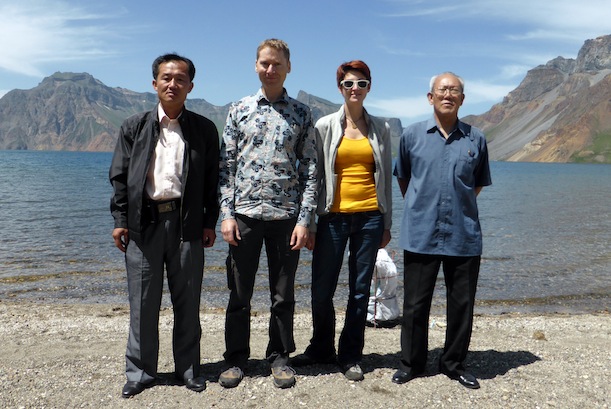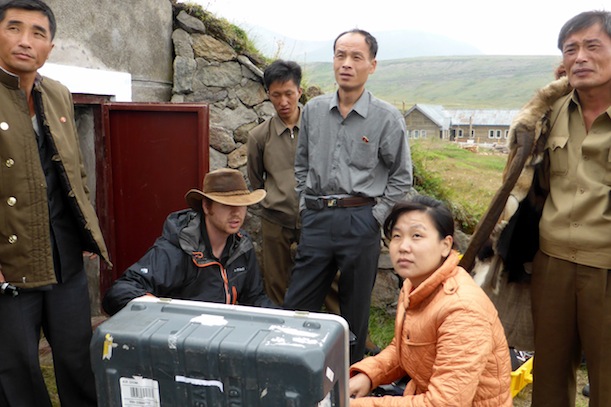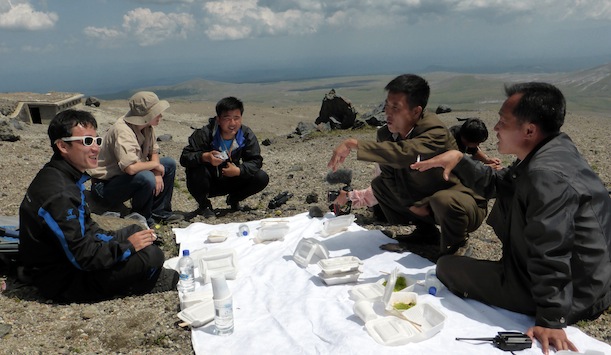On Conducting Science Atop a Volcano in North Korea
A team of Western scientists recently helped local researchers set up monitoring instruments on North Korea’s Mount Paektu, an active volcano
/https://tf-cmsv2-smithsonianmag-media.s3.amazonaws.com/filer/20130905010140P1000415-copy.jpg)
Last month, James Hammond, a volcanologist at Imperial College London, traveled with Clive Oppenheimer and Kayla Iacovino of the University of Cambridge to install six seismometers on Mount Paektu—an active volcano on the border of China and North Korea that is famous for, among other things, being the alleged birthplace of Kim Jong-Il. Hammond has previously placed seismometers in locales as far-flung as Eritrea, Ethiopia and the Seychelles, but installing them in North Korea was a new challenge.
“When I first told people about the project, there was a bit of disbelief. People thinking, ‘you must be mad,’” Hammond says. “At times, I even thought myself that it wouldn’t work out.”

Clive Oppenheimer and Kayla Iacovino (center left and right), along with two North Korean researchers, stand in front of Lake Chon, the volcano’s crater lake.
His team isn’t the only group of Western scientists to work in North Korea in recent years, but they are one of just a handful, and the first to install scientific equipment in the country’s natural environment. Their project began, Hammond explains, as a result of interest from North Korean researchers.
“The volcano has a pretty dramatic history,” he says. “About 1000 years ago, there was a huge eruption—it was among the top ten eruptions in recorded history, and it dropped ash more than 1000 miles away—so it’s got the potential to be very explosive.” Between 2002 and 2006, researchers on the volcano’s Chinese side observed increased seismic activity, along with slight swelling—both factors that could be harbingers of an upcoming explosion.
This increased unrest in the volcano led researchers in the Korean Earthquake Bureau to seek outside expertise in studying Paektu (sometimes spelled Baekdu, and called Changbai in China). They approached the Beijing-based Environmental Education Media Project (EEMP), which contacted Richard Stone, who was then the Asia editor of Science and had previously traveled in North Korea to document the country’s fight against tuberculosis. He, in turn, recruited Hammond and Oppenheimer to install equipment to help characterize the volcano’s activity and perhaps enable scientists to someday predict when it’ll erupt next.
After a weeklong information-gathering trip in 2011, they set about planning a research project, which Stone documents in a news article published today in Science. “No one had done much research into what drives the volcano, from a scientific point of view,” Hammond says.
That’s not a huge surprise, given both the international sanctions that prevent most people from visiting North Korea—let alone bring in scientific equipment—and the country’s ultra-secretive regime. Over the next few years, the group worked to cut through the bureaucratic red tape that prohibits bringing and using virtually all outside technology (including flash memory drives) into the country in preparation for their trip.
Then, last month, the trio returned and spent 16 days in the country. One of their primary goals was installing six seismometers in specially-built concrete huts on the mountain. The instruments—which precisely measure seismic movement in the ground—will eventually help Hammond and other scientists better understand the internal dynamics of Paektu.

James Hammond (wearing the hat) and Ryu Kum Ran (wearing the orange jacket) install a seismometer on Paektu Bridge, a few miles down the flank of the volcano from the crater
“Essentially, whenever earthquakes occur anywhere in the world, we’ll record them in North Korea, and use the way that energy interacts with the ground underneath to build an image of what the inside of the volcano looks like,” Hammond says. “If we can understand that, that can guide us in thinking about the potential for future eruptions.”
Additionally, Oppenheimer and Iacovino gathered geologic samples, mostly pumice, from a variety of sites around the mountain. “From collecting the rocks, you can get an idea of what state the volcano was in just before it erupted,” says Hammond.
They stored some of their equipment in the houses of local villagers, most of whom had never seen a Westerner before. “They were incredibly nice, really friendly,” Hammond says. “We even got to eat lunch with them on occasion. Everyone seemed happy to be involved, and recognized this was something important that needed to be done.”
Similar to how the few Westerners who visit North Korea as tourists are required to take part in a state-organized sightseeing tour, Hammond’s team was taken to see a series of officially-sanctioned sites. “We went to Kim Jong-Il’s birthplace, which is actually on the flanks of the volcano,” Hammond says. “And we saw Arirang, which is really special—it’s like 100,000 people doing gymnastics, and at the back they have 10,000 people holding cards that they flip around to make pictures.” Some of the cards, in fact, showed Paektu, which is traditionally considered an ancestral origin of Korean culture, in addition to Kim Jong-Il’s birthplace.
Hammond counts the trip as a big success. Logistical hurdles obviously remain—for the foreseeable future, for example, the seismometers’ data will be downloaded and sent out every few months by the Korean Earthquake Bureau, instead of transmitted in real time. Still, he found that working with North Korean researchers was not much different from working with scientists anywhere.
“Communication can be hard, but I found that once we got into the science, there was something of a common language for all of us,” he says. “They want to understand that volcano—that’s what drives them, and that’s what drives us as well.”
/https://tf-cmsv2-smithsonianmag-media.s3.amazonaws.com/accounts/headshot/joseph-stromberg-240.jpg)

/https://tf-cmsv2-smithsonianmag-media.s3.amazonaws.com/accounts/headshot/joseph-stromberg-240.jpg)